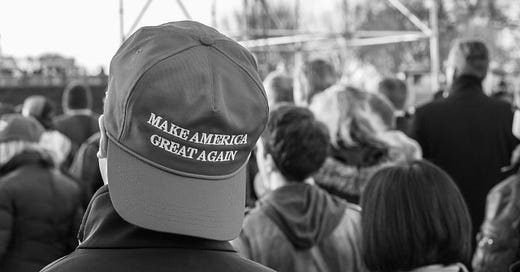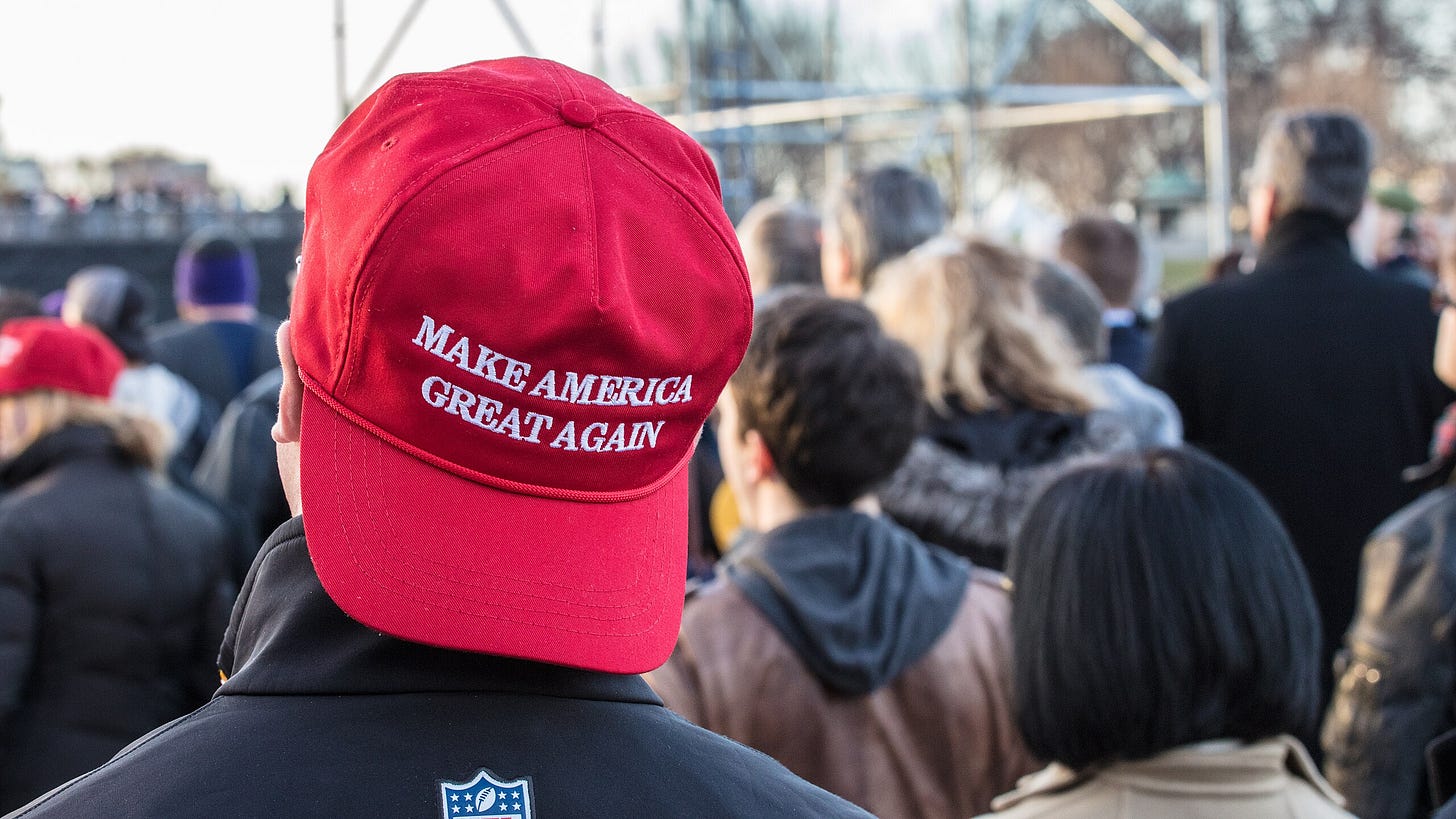This is sort of adapted from a project for my Global Politics class.
1.
has probably the best theory of American politics out there right now.On the left, he says, you have academics and intellectuals and white-collar workers who like to read and are motivated by abstract ideals. They have high IQs and signal virtue to gain respect among their peers. “Elite Human Capital.”
The right, however, is full of stupid, distasteful, and conniving scum. These people dislike academics because they use words with too many syllables, they watch Fox News and Tucker, and they hate immigrants. They have little education and signal vice. “Low Human Capital.”
Right now LHC is in charge. It might feel a little weird to say that—how can they not be elite if they’re in charge?
But then you see Trump or Kash Patel or Elon Musk speak or tweet or anything else, and it makes sense again. These guys might be in charge of some institutions—but they really hate institutions. All the institutions! The ones they’re in charge of and the ones they’re not.
This is sort of unprecedented in American history.
I mean, everyone thought George W. Bush was a little stupid. But he went to Yale and Harvard! And he expanded government institutions—not to glorify his ego, but because he really thought it’d be good for America. Most importantly, he surrounded himself with generally smart and dedicated advisors—not spineless yes-men. Bush was as EHC as they come.
What about Trump’s first term?
Again, the people around the president matter a lot. Trump and much of his base were certainly LHC—but his vice president wasn’t, and his cabinet wasn’t, and the rest of his party wasn’t. In other words, the ones actually in charge of the institutions—the RNC and the State Department and so on—respected and cared about those institutions. They were EHC!
What happened between then and now? Why is Lara Trump in charge of the RNC? What broke Marco Rubio’s will?
2.
Through the 90s, LHC populism wasn’t really in style. Both the Democratic and Republican Party establishments were strongly elite institutions. Sure, Pat Buchanan tried his damndest to win the Republican nomination on the back of bible-thumping racists—but he never really got close, even when he ran against the dullest man in the history of the US Senate.
Populists were relegated to the fringes of American politics. Of course, being populists, they were rather popular—so the fringes of American politics briefly got very impactfully popular! The Reform Party picked up nearly 20% of the 1992 vote, plus an eventual Minnesota governorship.1
And then two very important things happened: 9/11 and the 2008 Financial Crisis.
Here’s where it becomes important to differentiate between the different flavors of populism. The two primary axes are cultural and economic. Cultural populists harbor cultural grievances and rail against cultural elites—they hate immigrants and metrosexuals (and homosexuals, often). Economic populists, similarly, harbor economic grievances and rail against economic elites—they’re sympathetic to socialism, and tend to hate billionaires and landlords.
9/11 gave the right a mandate to bring cultural populists fully under their wing. Racism probably wasn’t a primary motivator for the Iraq War—in fact, Bush did somersaults to make clear that “the war against terrorism is not a war against Muslims, nor is it a war against Arabs. It's a war against evil people who conduct crimes against innocent people.”
But concepts crept, as they so often do, and the Republicans needed to build a bigger tent, so they took any hawks they could find. And so we got what the Wrong About Ukraine But Generally Great Substacker
’s called a Neo-Racist Foreign Policy. One based on stereotypes and broad denunciations of our adversaries—Cold War–esque, only it’s about maybe-rationally-motivated crappy little countries now, not a hulking over-ideological superpower.It’s hard to have such an aggressive foreign policy without a strict anti-immigration regime to match it—that’s a disequilibrious dissonance—so Republican attitudes toward immigration turned sour.
By the end of the Bush administration, the right had taken a markedly populist turn in general—even the superficially libertarian Tea Party movement came out strongly against immigration.
The left began to react with blind anti-populism, simply opposing whatever Republicans said about immigration.
The Democrats were trying to put space between themselves and the gross, xenophobic, foreigner-hating hoi polloi. By 2008, cultural populism belonged squarely to the right, and cultural elitism to the left.
What about the economic flavor?
Well, in 2008, Wall Street exploded, and then the rest of the country exploded too. More precisely, Wall Street blew itself up. Idiots were engaged in idiotic trading, and it was bound to catch up to them. Everyone knew this was the rich’s fault (even if they didn’t know exactly why).
And Obama bailed out the banks!2
The left were already the party of high taxes and overbearing government, so certain parts of their base got big mad about this. Wall Street was Occupied, the Senate was treated to eight and a half hours of Bernie Sanders, and so on.
Americans who came of age around this time tended to walk away with extremely socialistic views. They viewed redistribution favorably, believed wealth came from exploitation, and felt angry simply hearing about rich people. The trend was especially strong among Democrats—in 2019, 40% of under-30 Dems supported Bernie, compared to 14% of those older than 65.
Once Obama’s term had ended, the extent of the economic populist capture of the Democratic Party became clear—in 2016, Bernie won a lot of primaries, many many more than someone like Jesse Jackson ever did.3
3.
Ok, 2016, Trump wins. Cultural populism into the White House, but surrounded by enough ideologically-motivated people not to completely corrupt the institutions of American governance.
The resistance liberals began to do their resistance liberal thing, pushing the Democrats toward increasingly crazy and unpopular stances on race and gender and so on.
Then Covid hit! And the summer of Black Lives Matter protests!
Lots of prominent Democrats got on a stage and said lots of crazy things, like that illegal immigrants should receive free healthcare, or that felons should receive taxpayer-funded gender reassignment surgery.
But the field was too crowded, and the risk of a Trump win too great, so the doddering moderate was nominated, and he won in the general because everyone realized that Trump handled Covid poorly, leading to lots of unnecessary deaths and suffering.
During the Biden presidency, though, a sneakier effect of the pandemic appeared.
Inflation!
See how the line picks up right after Biden took office? It’s an unfortunate coincidence more than anything else, but it meant that Biden took a lot of the blame for higher prices.
Really, he took all of the blame from most Americans. Unlike in 2008, there wasn’t anyone clearly responsible for their economic hardship. Supply shocks are pretty impersonal, harder to scapegoat. Leftists tried to blame billionaires and corporations, but it didn’t really take.
The people were mad about the economy! Economically disgruntled. And the left wouldn’t sell them a convincing narrative blaming someone else, so the right stepped in!
And they blamed all the elites they could find. DEI bloat and illegal immigrants and The Swamp. The right began to intertwine economic and cultural populism, shedding the Tea Party–remnants who liked big business, and embracing quasi-socialisms like aggressive antitrust and tipped worker tax exemptions.
Trump was elected in 2024 on the back of LHC because he was able to produce a convincing fusion of all the different flavors of populism. The Bernie Bro to MAGA pipeline is well-documented, and well-explained by this view.
The Republican Party is, ultimately, beholden to its voters. And its voters absolutely love the Trumpian populist fusion. JD Vance got in line and Marco Rubio got in line, and so did anyone else who wanted a future in right-wing American politics.
American institutions were captured by LHC because they could finally rally around a single choice. Just look at Trump’s vote share in the inner city relative to 2020 and 2016! The left loosened their grip on economic populism, and so Trump developed a message which successfully spoke to dimwits of all stripes.
In Part 2, I’ll expand this populist-realignment analysis globally…
I highly recommend Jon Bois’ documentary series on the Reform Party…
Of course, this was almost certainly the right move. It was less of a bailout and more of an investment, actually… the taxpayer made money!







